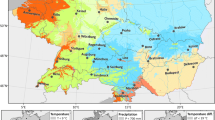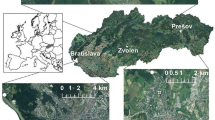Abstract
Terrestrial snail faunas were studied at 273 sites in three large Czech cities (Prague, Pilsen and Hradec Králové). The aim was to explore the effect of habitat degradation on land snail diversity in urban environments. Of the 81 species recorded, 12 were considered synanthropic and 29 anthropophobic. We assessed the power of habitat degradation and distance from the city centre as predictors of species richness for: (1) all species combined; (2) synanthropic species alone; and (3) anthropophobic alone. The highest correlation was observed between richness of athropophobic species and habitat degradation (average r = −0.69, P < 0.001), which explained on average 48% of the variation, whereas distance from the city centre explained a negligible amount of independent variation. A similar pattern was found for all species combined; however, the amount of explained variation was lower (10% on average). We found a contrasting pattern for the richness of synanthropic species whose occurrence was mainly and negatively driven by the distance from the city centre. However, the amount of explained variation was very unequal among the cities, being very low in Prague and Pilsen (8%) and quite high in Hradec Králové (36%). In conclusion, the response of local snail assemblages along a gradient of habitat degradation can be generalised as a gradual decline in species richness, especially of rare and anthropophobic species. This reduction was independent of the sites’ position within the city, which highlights the importance of natural habitats for the maintenance of snail diversity in urban environments.



Similar content being viewed by others
References
Bajdashnikov AA (1992) Terrestrial mollusk fauna of the Ukrainian Polesie Area. Communication 1. Specific composition and connection with vegetative cover. Vestn Zoologii 4:13–19 (in Russian)
Barker GM (ed) (2002) Molluscs as crop pests. CABI Publishing, Wallingford
Baur A, Baur B (1993) Daily movement patterns and dispersal in the land snail Arianta arbustorum. Malacologia 35:89–98
Benešová M (1958) Josef Gočár. Nakladatelství československých výtvarných umělců, Praha
Beran L, Juřičková L, Horsák M (2005) Mollusca (měkkýši). In: Farkač J, Král D, Škorpík M (eds) (Red list of threatened species in the Czech Republic. Invertebrates. AOPK ČR, Praha, pp 69–74
Cameron RDA, Pokryszko B (2005) Estimating the species richness and composition of land mollusc communities: problems, consequences and practical advice. J Conchology 38:529–548
DeCandido R, Muir AA, Gargiullo MB (2004) A first approximation of the historical and extant vascular flora of New York City: implications for native plant species conservation. J Torrey Bot Soc 131:243–251. doi:10.2307/4126954
Dedov I, Penev L (2000) Species composition and origins of the terrestrial gastropod fauna of Sofia City, Bulgaria. Ruthenica 10:121–131
Dedov I, Penev L (2004) Spatial variation in terrestrial gastropod communities (Gastropoda, Pulmonata) along urban-rural gradients in Sofia City, Bulgaria. In: Penev L, Niemelä J, Kotze J, Chipev N (eds) Ecology of the city of Sofia. Species and communities in an urban environment. Pensoft Publishers, Moscow, pp 307–318
Duhme F, Pauleit S (2000) A landscape ecological master plan for the city of Munich. In: Riley JO, Page SE (eds) Habitat creation and wildlife conservation in Urban and post-industrial environments. Packard Publishing, Chichester
Fernández-Juricic E (2002) Can human disturbances promote nestedness? A case study with breeding birds in urban habitat fragments. Oecologia 131:269–278. doi:10.1007/s00442-002-0883-y
Frest TJ (2002) Native snails: indicators of ecosystem health. In: Wuerthner G, Matteson M (eds) Welfare ranching, the subsidized destruction of the American West. Island Press, Washington DC, pp 211–215
Gilbert OL (1989) The ecology of urban habitats. Chapman and Hall, London
Green RJ (1984) Native and exotic birds in a suburban habitat. Aust Wildl Res 11:181–190. doi:10.1071/WR9840181
Juřičková L (1995) Molluscan fauna in the territory of Prague aglomeration and its development in urban influence. Natura Pragensis 12, Český ústav pro ochranu přírody, Praha (in Czech)
Juřičková L (1998a) Mollusca of Plzeň, West Bohemia, Czech Republic. Sborník Západočeského Muzea Plzeň. Prir 96:1–47 (in Czech)
Juřičková L (1998b) Mollusca of Hradec Králové, East Bohemia, Czech Republic. Acta Musei Reginaehradecensis s A 26:101–172 (in Czech)
Juřičková L, Horsák M, Beran L, Dvořák L (2008) Check-list of the molluscs (Mollusca) of the Czech Republic. http://mollusca.sav.sk/malacology/checklist.htm, last update: 26 August 2008
Kerney MP, Cameron RDA, Jungbluth JH (1983) Die Landschnecken Nord und Mitteleuropas. Paul Parey Verlag, Hamburk
Klausnitzer B (1993) Okologie der Grossstadtfauna. Jena, Stuttgart
Klausnitzer B, Hubner M (1989) Zur Landschneckenfauna des Stadtgebietes von Leibzig. Malakologische Abh Mus Tierkunde Dresden 14:119–124
Knapp S, Kühn I, Mosbrugger V, Klotz S (2008) Do protected areas in urban and rural landscapes differ in species diversity? Biodivers Conserv 17:1595–1612. doi:10.1007/s10531-008-9369-5
Kowarik I (2003) Biologische Invasionen: Neophyten und Neozoen in Mitteleuropa. Verlag Eugen Ulmer, Stuttgart
Kühn I, Klotz S (2006) Urbanization and homogenization—comparing the floras of urban and rural areas in Germany. Biol Conserv 127:292–300. doi:10.1016/j.biocon.2005.06.033
Kühn I, Brandl R, Klotz S (2004) The flora of German cities is naturally species rich. Evol Ecol Res 6:749–764
Ložek V (1956) Key of Czechoslovak Molluscs. Vydavatelstvo SAV, Bratislava (in Czech)
Mason CF (2006) Avian species richness and numbers in the built environment: can new housing developments be good for birds? Biodivers Conserv 15:2365–2378. doi:10.1007/s10531-004-1236-4
Matzke M (1979) Landgastropoden innerhalb einer Kleinstadt am Beispiel von Lichtenstein am Fuße des Westergebirges. Malakologische Abh Mus Tierkunde Dresden 6:145–167
McKinney ML, Lockwood JL (2001) Biotic homogenization: a sequential and selective process. In: McKinney ML, Lockwood JL (eds) Biotic homogenization. Plenum Publishers, New York, pp 1–77
Niemelä J (1999) Ecology and urban planning. Biodivers Conserv 8:119–131. doi:10.1023/A:1008817325994
Pyšek P (1998) Alien and native species in Central European urban floras: a quantitative comparison. J Biogeogr 25:155–163. doi:10.1046/j.1365-2699.1998.251177.x
R Development Core Team (2007) R: a language and environment for statistical computing. R Foundation for Statistical Computing, Vienna
Ricotta C, Godefroid S, Celesti-Grapow L (2008) Common species have lower taxonomic diversity evidence from the urban floras of Brussels and Rome. Divers Distrib 14:530–537. doi:10.1111/j.1472-4642.2008.00467.x
Schwartz MW, Thorne JH, Viers JH (2006) Biotic homogenization of the California flora in urban and urbanizing regions. Biol Conserv 127:282–291. doi:10.1016/j.biocon.2005.05.017
Smith RM, Warren PH, Thompson K, Gaston KJ (2006a) Urban domestic gardens (VI): environmental correlates of invertebrate species richness. Biodivers Conserv 15:2415–2438. doi:10.1007/s10531-004-5014-0
Smith RM, Gaston KJ, Warren PH, Thompson K (2006b) Urban domestic gardens (VIII): environmental correlates of invertebrate abundance. Biodivers Conserv 15:2515–2545. doi:10.1007/s10531-005-2784-y
Sverlova NV (1999) Historical changes in land molluscs fauna (Gastropoda: Pulmonata) in the large city (Lviv as a model). Naukovii Visnik 8:127–131 (in Ukrainian)
Tappert A (1995) Die Molluscenfauna von Koln. Dacheniana, Beihefte 35:579–643
Wang G, Jiang G, Zhou Y, Liu Q, Ji Y, Wang S, Chen S, Liu H (2007) Biodiversity conservation in a fast-growing metropolitan area in China: a case study of plant diversity in Beijing. Biodivers Conserv 16:4025–4038. doi:10.1007/s10531-007-9205-3
Wiktor A (2004) Land snails of Poland. Wydawnictwo Mantis, Olsztyn (in Polish)
Acknowledgments
For comments on the manuscript we thank Milan Chytrý, Nicole Cernohorsky and especially two anonymous reviewers. We are very grateful to Associate Editor Robert Cowie for comments and correcting the English. Funding comes from grants IAA601630803, MSM 0021622416, and MSM 0021620828.
Author information
Authors and Affiliations
Corresponding author
Appendix
Appendix
See Table 5.
Rights and permissions
About this article
Cite this article
Horsák, M., Juřičková, L., Kintrová, K. et al. Patterns of land snail diversity over a gradient of habitat degradation: a comparison of three Czech cities. Biodivers Conserv 18, 3453–3466 (2009). https://doi.org/10.1007/s10531-009-9654-y
Received:
Accepted:
Published:
Issue Date:
DOI: https://doi.org/10.1007/s10531-009-9654-y




